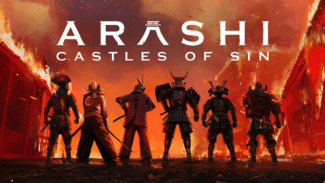Arashi’s open-ended sneaking eventually beats out its clumsier elements. More in our Arashi: Castles of Sin review.
Let’s take a moment to talk about Haru. She is, without a doubt, VR’s goodest dog or, to be more accurate, wolf. She’s lovable in her doe-eyed affection and convincing in the way her fur and ears realistically ruffle to the touch. She’s also dependably loyal to your command, leaping on enemies without a moment’s hesitation and, yes, she’s inescapably goofy too. Sometimes that’s intentional like when playing fetch between missions and sometimes less so, like when walking vertically up a wall.
Quirks aside, Endeavor One really outdid itself with this virtual companion – she’s an enamoring blend of authentic, entertaining and clumsy all at the same time. Arashi: Castles Of Sin is much the same story.
Right from the start, you can tell this PSVR-exclusive stealth game — in which you infiltrate castles to overthrow notorious warlords — is a labor of love. Nioh, Sekiro and Tsushima set the bar high for stylish takes on Japanese history and, although unmistakably a lower budget effort, Arashi does its best to carry that trend forward with stunning hand-drawn cutscenes that are a treat to behold, Japanese voice-overs and fantastic art direction that really captures an accurate if slightly blurry and haggard feudal Japan. Though most levels mainly boil down to a series of walls and grassy patches, each has distinct standout moments to take in.
Gameplay is similarly ambitious. Endeavor One aims for wide-open level design that lets players pick and choose how they approach any given situation. The game is linear but each area has multiple routes through to the next, catering to a mix of non-lethal or more combative gameplay. You’re mostly free to choose whether to stick to the long grass or, ammo permitting, unleash a barrage of arrows, mines, grenades and even poisoned onigiri (the latter of which guards will hastily and hilariously scoff upon discovery). Or, of course, Haru’s vicious bite is almost always just a call away.
The amount of choice on offer is impressive, even if many of the extra weapons simply boil down to throwing or shooting a different kind of item with similar results. Whether picking enemies off whilst sneaking through grass or darting across rooftops with a hookshot to avoid them entirely, Arashi often nails its stealthy thrills, and it’s definitely possible to replay the five lengthy levels — which total out to about 4 – 5 hours of playtime — and adopt different paths and playstyles almost right the way through. It also helps that motion controls are implemented well, and that Endeavor One clearly knows its way around the pesky Move controllers.
Paired with the varied level design, the game comes together to offer plenty of rewarding moments, like when trading arrows with watchtowers across misty canyon scenery, or dangling above unsuspecting guards and slicing them as you drop towards the ground. If a rare difficulty spike was getting the best of me I could almost always find a hidden path that allowed me to avoid the encounter altogether or a vantage point to pick off troublesome foes. While not as open-ended as, say, Budget Cuts, it’s hard to find a VR game as versatile as this.
Where Arashi stumbles, at least early on, is in getting players to embrace that versatility.
For starters there’s no kind of rating or reward system for tackling levels in a certain way, meaning there’s no reason to set yourself the extra challenge of reducing your body count and leaving guards unharmed. Within the game’s first 10 minutes you gain its deadliest tools; arrows, shurikens, and Haru. The former two allow you to silently kill most enemies at range with a single hit anywhere on the body and, while ammo isn’t overflowing, it’s hardly scarce either. Haru, meanwhile, provides an unending source of distractions and attacks to lean on.
It’s not until the game’s last two levels that things get trickier, with enemies either doubling up or going out on patrol with more armor. And this is where Arashi really shines, with tightly-designed sequences that force you to improvise and truly take on your role. It takes a little a while to get going but, once it does, it’s fantastic.
Even then, though, the rules of the stealth mechanics are pretty forgiving: you can stand right in front of enemies in long grass without them so much as batting an eyelid, and bodies disappear so you don’t need to worry about others discovering them out on patrol. You can also immediately highlight nearby enemies with the tap of one button and walking doesn’t make a sound unless you break into a sprint. The short-range jump, meanwhile, works a bit like a get out of jail free card, allowing you to instantly hop between grassy patches and, if you’re so inclined, even find plenty of spots in the level design to exploit.
Enemy AI is also spotty, and they’re not always able to detect actions that should be a dead giveaway. Even if you are discovered you can simply jump into the area’s exit and spawn in the next map completely undetected or call on Haru to distract a foe and kill them before getting into a fight. There’s not even any penalty to Haru being discovered, there’s just a giant, deadly wolf walking around enemy encampments and no one really seems to mind.
I understand Arashi’s desire to empower players and let them step into the role of a lethal assassin, but I wish the game challenged me more right the way through, either through its own difficulty or giving me reasons to self-impose some restrictions on how I played.
It’s a little easy-going, then, but I still really enjoyed Arashi’s stealth elements. Even though a feather-light tap of a sword can crumple an enemy in an instant I found myself playfully acting out deadly swipes and savoring the moments I’d lean around corners to fire off an arrow. Endeavor One does a great job of making each level and the areas within feel distinct and every time I left one area I felt genuinely curious to see what the developer would throw at me in the next.
More troublesome, though, is the game’s messy sword combat which, if anything, provides the main motivation to fully embrace the stealth. Battles mostly consist of you first blocking an enemy’s attack and then retaliating with the opening you’re given. It can work when enemies stay rooted to the spot but they’re often on their toes and step forward into you, bypassing your block. It’s hard to regain your footing when you’re trying to block with the same hand that controls the direction of movement and I’d often find the game was registering attacks I wasn’t intending to make, killing enemies with even just the slightest hand movement.
This can also make the repetitive boss battles, which only really differ in the types of special attacks they do, a frustrating disappointment. It’s a real shame given the incredible character design and backstories that have gone into each. There’s the start of a decent melee system here but it feels like it needs a more directed approach in the vein of Until You Fall’s on-screen indicators to really reign it in and make it more cohesive. It’s fortunate for Arashi that this element is only one small part of the overall experience.
There’s definite structural problems with Arashi, but I ultimately found the fantastic level design and amount of player freedom kept me tackling its levels with enthusiasm. Its issues are inherent, but never turned the experience into a slog or made me want to turn it off, and I was glad to have negotiated my way through its meaty campaign, warts and all.
Arashi: Castles Of Sin Review – Final Impressions
Arashi: Castles Of Sin might not go down as VR’s answer to Tenchu, but it gets a lot right with its open-ended level design and its fantastic realization of Feudal Japan. It’s a rare VR game that gives you genuine choice in deciding how to get from A to B and, when it works, captures the slick elitism of becoming a ninja. But it’s let down by clumsier elements, like bugs, bad enemy AI and underwhelming sword combat. Even these dark forces combined aren’t enough to derail the fun sneaking at the core of the experience, but there’s plenty of room for Arashi to improve with a potential sequel.








